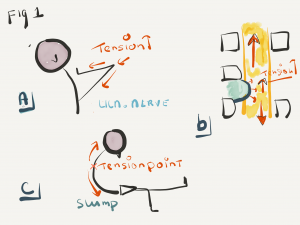Is “to stretch” a nerve and “to put tension” on it an appropriate terminology in manual therapy education and daily practice?
Before you starting reading this blog, it has to be mentioned that it is restricted to the biomechanics of peripheral nerves. I hope it will give you some interesting thoughts for education and clinical work
Education of the evaluation of the peripheral nervous system in musculoskeletal pain and disorders is a major part of IMTA courses-During the last decade other musculoskeletal concepts in Europe followed the IMTA example. An important part of the nerve assessment is to evaluate the mechanosensitivity by a standardized movement maneuvers like the Upper Limb Neurodynamic Test (ULNT), the straight leg raise (SLR), the Slump and Prone Knee Bend (PKB) test. Related to the curricula, clinical experience and literature, manual therapy teachers educate their students in most cases with the following premises;
language which is common used during courses and practice
• Nerves move but increase in tension special if there is a “pre-stretch” in a standardized neurodynamic position (Fig1.a)
• Altered (abnormal) mechanical interfaces reduce nerve movement and increase nerve “tension” (fig 1b.)
• “Tensioners” as a treatment maneuver stretch the nerve
• Tension points are areas were the nerve adapts more to “tension”.(fig 1c)
• The Range of Resistance (from the first resistance R1 up to the limit of Resistance –R2) during a neurodynamic test is caused by increasing nerve “tension“
Fig1 Examples of drawings used to explain neurodynamics during education and in the clinic
1a. Ulnar Tension on the medial condyle in extreme neurodynamic position of the ulnar nerve
1b. Abnormal mechanical interface; bulging disc contacting the spinal cord during movement
1c Classic tension point during slump position
Related with this knowledge clinicians who imbedded neurodynamic knowledge into their practice maybe explain nerve mobilization as a more mechanical concept were Terms like nerves “glide”,”tension” and “stretch” are regularly used.
From literature, it may be concluded that biomechanical effects like movement, stress and tension of neurodynamic testing and limb movements have not been fully systematically determined, particular the effects of nerve dynamics during the more terminal ranges of neurodynamic tests and treatment techniques. From physics stress is defined as a force per unit area. It appears during a neurodynamic tests as tensile, compressive and shear stresses (Abrams et al 1998, among others). Tensile stresses can occur either parallel (longitudinal) or perpendicular (transverse) to the longitudinal axis of the nerve (Topp et al 2006). Strain may be defined as the relative deformation of a structure and can be estimated from the measured difference of nerve excursion at two different measuring points divided by the distance between these points [Vanti et al 2010, among others). In the domain of physical therapy “stretching” of a nerve is explained as a movement that places the tissue under maximum tolerable strain with the aim to cause change in tissue flexibility (Topp et al 2006.)
From a evidence based perspective, manual therapy educators and clinicians have to reflect what happens biomechanically with a peripheral nerve during increasing resistance and mechanical sensitivity changes while performing a test or during treatment. The reason for this is to inform students and patients more appropriately and to facilitate ideas for new treatment approaches or modalities.
Studies performed on human cadavers support the hypothesis that different neurodynamic test maneuvers induce a significant increase in nerve strain (Zoech et al 1991). Further, the tests are accompanied with longitudinal nerve excursion and strain (Kwan et al 1992). However, it is questionable whether we can transfer the evidence of nerve stress and strain from this scientific setting to living humans. Recently, a systematic review from Silva et al. (2014) reviewed the evidence of in vivo longitudinal nerve excursion during different joint movements. The authors concluded that joints might induce nerve gliding rather than increase of strain (Silva et al 2014).
A systematic review published by Szikszay et al (2017) on the mechanical behavior of the peripheral nervous system under elongation and tension in vivo supports that ‘ “stretching” and “tension” might not be the appropriate terminology. This review included 22 Studies and found that during peripheral nerve movement in vivo, complex biomechanical changes occur in peripheral nerves. These consist of longitudinal and transverse nerve excursion and changes in diameter rather than anatomical elongation (including axon and nerve connective tissue). Increased adjacent muscular activity may support the clinical resistance (R1-R2) rather than tension or strain of nerve tissue. It is concluded that limb movement induces complex biomechanical effects of which nerve elongation plays only a minor role.
From this perspective manual therapy educators and clinicians should use the term “stress” and “tension” with caution. It might be an idea do change them to the words “movement”, ”adaptation”, “diameter changes” while teaching and informing doctors and patients.
Suggestion for more appropriate language
• Nerve movement is complex and is challenged on movement “adaptation” during an increased standardized neurodynamic position
• A Nerve is challenged by a variability adaptation of movements like transverse movement or diameter changes of during adjacent (abnormal) mechanical interfaces
• The resistance felt during a “tensioner” is more an increase of muscle activity around the nerve than elongation (connective tissue of the nerve or axon).
• The mechanism of tension points are not known. Probably there is an increased nociception of surrounding tissue during loading the nerve rather than stretching or elongating of nerve tissue
• Range of Resistance (R1–R2) during a neurodynamic test may dominantly be related with increased muscle protection than nerve loading
fit 2
In fig 2 is a suggested sketch/drawing which may be used to explain neurodynamics avoiding the words “stretch” and “tension”
Fig 2a classic explanation of pain or increased mechanosensitivity due to Ad C fibre barrage for the nerve connective tissue into the dorsal horn by increased stress , tension of the nerve
Fig 2b Pain/ mechanosensitivity explanation of increased muscle activity whereby the tension/ pain is associated with an increased Ad an C fibre barrage of the muscle more than the nerve who still adapts on movement.
Good luck :-)
Harry von Piekartz
Literature
Abrams RA, Butler JM, Bodine-Fowler S, Botte MJ. Tensile properties of the neurorrhaphy site in the rat sciatic nerve. J Hand Surg Am 1998; 23(3): 465-70
Kwan MK, Wall EJ, Massie J, Garfin SR. Strain, stress and stretch of peripheral nerve rabbit experiments in vitro and in vivo. Acta Orthop Scand 1992; 63(3): 267-72
Silva A, Manso A, Andrade R, Domingues V, Brandão MP, Silva AG. Quantitative in vivo longitudinal nerve excursion and strain in response to joint movement: A systematic liter- ature review. Clin Biomech (Bristol, Avon) 2014; 29(8): 839- 47. doi: 10.1016/j.clinbiomech.2014.07.006.
SzikszayT,Hall T,von Piekartz H. In vivo effects of limb movement on nerve stretch, strain, and tension: A systematic review , Journal of Back and Musculoskeletal Rehabilitation -1 (2017) 1–16 DOI 10.3233/BMR-169720
Topp KS, Boyd BS. Structure and biomechanics of peripheral nerves: Nerve responses to physical stresses and implications for physical therapist practice. Phys Ther 2006; 86(1): 92-109
Vanti C, Bonfiglioli R, Calabrese M, Marinelli F, Guccione A, Violante FS, Pillastrini P. Upper limb neurodynamic test 1 and symptoms reproduction in carpal tunnel syndrome. A validity study. Manual Therapy 2011; 16(3): 258-263. doi: 10. 1016/j.math.2010.11.003.
Zoech G, Reihsner R, Beer R, Millesi H. Stress and strain in peripheral nerves. Neuro Orthop 1991; 73-82.





Comments